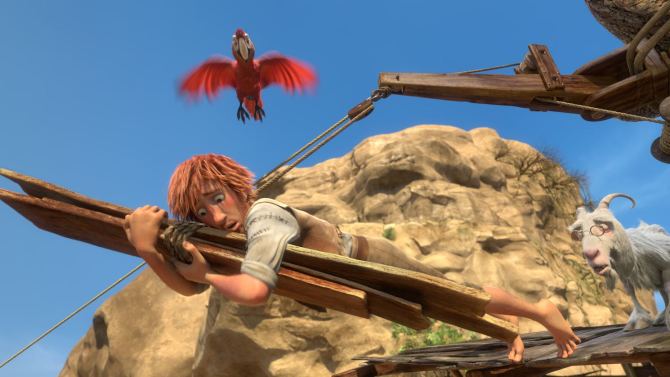
https://brenjitukuat.com/ brenjitu https://dreamsecret.com.ua/brenjitu/ https://dreamsecret.com.ua/brenjitu/ https://www.littlegoa.com/catalog/view/ https://167.172.131.64/ http://www.mercedeslence.com/ https://brenjitutu.my.id/ https://www.yamaarashi.be/ https://phamtienhung.vn/ http://web.akfarcefada.ac.id/ https://shop.vdarts.net/vendor/filp/whoops/

nWave's latest dynamic 3D toon reimagines Robinson Crusoe as the ultimate party-crasher, telling his story from the p.o.v. of the animals whose tropical paradise he invaded.
For nearly three centuries, audiences have marveled at the “strange surprizing adventures” of Robinson Crusoe, “who lived eight and twenty years, all alone in an un-inhabited island on the coast of America.” Well, not entirely alone. Crusoe shared his oasis with birds and beasts aplenty, and thanks to the magic of computer animation, the critters finally get a chance to tell their side of the story in “The Wild Life,” which plays like a watered-down version of Aardman’s “The Pirates! Band of Misfits.” Already released in Germany and rolling out across Europe in advance of Lionsgate’s Sept. 9 Stateside release, this tame, kid-friendly marooned cartoon should do well for nWave, the stereo-savvy Belgian animation studio behind “A Turtle’s Tale: Sammy’s Adventures” and “Thunder and the House of Magic,” whose dynamic use of 3D somewhat compensates for otherwise flat storytelling.
Whereas Crusoe recounted his own narrative in Daniel Dafoe’s first-person novel, it’s a bright red parrot named Mak (David Howard) who does all the talking here. Unlike his fellow islanders — an exotic mix of species, including a blubbery tapir named Rosie (Laila Berzins) and the needle-voiced echidna Epi (Sandy Fox), both more than content with their daily luaus and all-you-can-eat bug buffets — Mak dreams of a bigger world out there, squawking, “How much paradise can a bird take!?”
When Crusoe’s ship smashes upon the rocky shore, Mak sees his ticket off the island — nevermind that he technically has “eight and twenty years” to wait. Meanwhile, the other animals approach the strange ginger-haired castaway with caution, studying this tall, gangly outsider from a distance. (Crusoe isn’t especially appealing, as animated humans go, though he’s been designed to emphasize his thin limbs and bendy knees and elbows, and it’s amusing to watch him flail about and fall on his bum.)
Though the animals all speak English amongst themselves, they don’t understand Crusoe (Yuri Lowenthal), watching from behind a rock as he unloads his supplies and recoiling in shock when the unfamiliar creature removes his coat. “Look, he’s stripped off his skin!” gasps kingfisher Kiki (Lindsay Torrance), while chameleon Carmello (Colin Metzger) does his best to disappear (a neat trick that slyly uses the 3D format to suggest near-invisibility). This clever animal-centric perspective, reminiscent of such kidlit staples as “Mr. Revere and I” and “Ben and Me,” not only suggests that the hapless young mariner might never have made it home by himself, but offers a playfully anti-imperialistic spin on Dafoe’s classic tale of Western superiority.
Of course, the animals need Crusoe, too, and he will soon become their closest ally in a battle for control of the island, which could soon be overrun by a pair of scraggly cats (Debi Tinsley, Jeff Doucette). The only other survivors of the storm, not counting Crusoe’s faithful golden retriever, these mangy ratters are Gremlin-ugly and act like “The Lion King’s” conniving hyenas — the total opposite of Thunder, the cuddly cat star of nWave’s last outing. In a rare twist for a kids’ cartoon, the dog dies — after which the feline culprits are banished to the bug-infested Curse Island, though they’ll be back to unleash more mayhem in the final reel, this time accompanied by a legion of equally unpleasant offspring.
In the meantime, Mak succeeds in making friends with Crusoe, earning the nickname “Tuesday” in the process (one of the project’s few nods to the novel, wherein the hero rescued a savage sidekick and dubbed him Friday). The animals pitch in as Crusoe builds a giant treehouse and beacon to attract passing ships, while co-directors Vincent Kesteloot and Ben Stassen manage to transform what might otherwise be years of sheer boredom (during which Crusoe sprouts a big red beard) into high-energy excitement — for easily appeased young audiences, at least.
While other animation studios have begrudgingly adopted stereoscopic 3D, embracing the box office bump the technology provides without necessarily adapting to how it can alter (and potentially improve) the viewing experience, Belgian nWave was among the first outfits to truly embrace the added dimension. From the early, eye-crossing antics of “Fly Me to the Moon” to the nimble, virtual-camera trickery of “The House of Magic,” Stassen has been a major innovator in the 3D space, and “The Wild Life” offers them another dynamic playground in which to run amok. Whether dangling characters off the edge of a cliff or zooming around Crusoe’s rickety wooden waterslide, the story is constantly on the go, launching objects and characters along the Z axis — and out over the audiences’ heads.
Considering that nWave doesn’t have the budget to compete with DreamWorks or Pixar (typically the most conservative when it comes to 3D), this strategy sets “The Wild Life” apart. But it should also be noted that the filmmakers, who dub and distribute the film in multiple languages, have finally mastered the element that nearly always trips up Euro-based toon studios: They’ve ensured that the dialogue and jokes actually work in English, casting appealing (if not necessarily recognizable) voices across the board.
